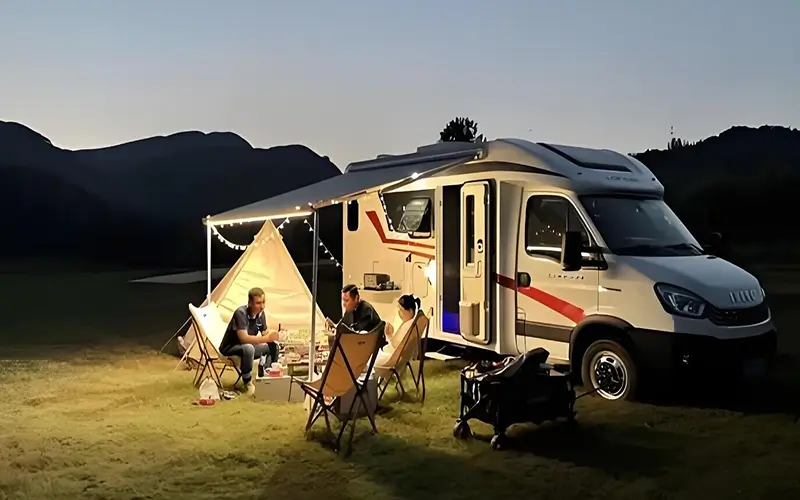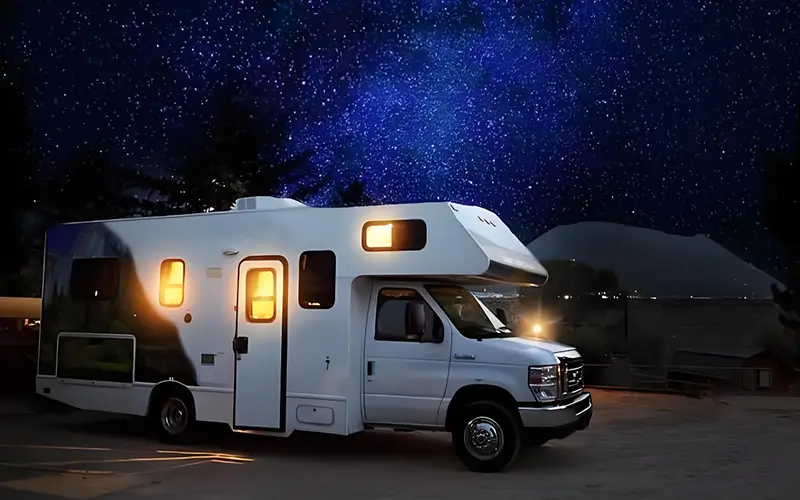
RVs are now a new pursuit for many young people, and many people choose to drive RVs for fun. LED lights have also become the first choice for RVs. They can provide bright lighting when camping, and can also add beauty and practicality to RVs. It is also to improve safety when driving at night. This article will explore in depth the various aspects of can you put LED lighting in exterior RVs? including their functions, choosing suitable lamps, and safety precautions during installation.
What is the Role of LED Lighting on the Exterior of RVs?
LED lights are also widely used to decorate RVs, mainly because LED lights are multifunctional. The main role is to improve safety, practical lighting, and aesthetics.
Safety: LED lights greatly improve the safety of RVs. First of all, when driving at night, the LED lights on the outside of the RV can significantly improve the visibility of the vehicle, which can reduce the risk of accidents. In addition, when you temporarily park the RV outside, it serves as a reminder, providing a certain level of safety protection for both you and the other party.
Lighting: When camping or parking, the external LED lights can provide sufficient lighting for the surrounding environment. It is very convenient to prepare dinner and clean up equipment at night, and LED lights can provide the required light. In addition, the lighting on the outside of the RV can enhance your camping experience and ensure the visibility and safety of the surrounding environment.
Aesthetics: You can use the flexibility of LED lights to decorate both the interior and exterior of the RV, enhancing its overall visual effect. By choosing LED lights of different colors and brightness, you can embellish your RV and make it more attractive at night.
What Kind of LED Lighting Can be Used for RVs?
When choosing LED lighting for RVs interior and exterior, functionality and feasibility should be considered first.

Versatility
The selected LED lights need to be used indoors and outdoors in RVs, and then dimming and multi-color options are possible so that they can meet the needs of different scenes. When you need to illuminate, you can use a high-brightness light source. When we are camping and eating, we can choose soft warm-toned lights, which will be more atmospheric.
Durability
LED lights must be durable because RV LED lights must be able to withstand various adverse weather conditions, such as high temperature, low temperature, rain, snow, and strong wind. Therefore, it is also necessary to pay attention to waterproofing and sun protection, so there is a choice of appropriate waterproof level. This ensures that the lamps can work properly in various environments.
Energy saving
RVs have a limited energy supply, so it is crucial to choose low-energy LED lights. Low energy consumption can extend the battery life while reducing dependence on generators, thereby better-saving energy.
What LED lighting can be installed Exterior the RVs?
The LED lights on the exterior of RVs need to have specific functions, such as lighting, decoration, and warning. The following are several recommended LED light strips for the exterior of RVs.
Projection lights: Projection lights can usually be installed on the front or top of the RV. It can properly illuminate the road ahead or a wide area of the campsite. While ensuring the safety of driving at night, it can also provide sufficient light for outdoor activities.
LED Strip lights: LED Strip lights can be installed on the side of the RV, mainly for decoration, adding a sense of fashion to the RV, and can emit unique light and shadow effects at night.
Side marker lights and tail lights: People mainly use these lights to improve the recognition of RVs on the road. Drivers usually install side marker lights on the side of the RV to warn other vehicles, while they place tail lights at the rear to ensure visibility at night or in bad weather conditions.
Bottom lights: Drivers install bottom lights around the chassis of the RV, which proves particularly useful when parking at night. It can achieve low-level lighting, which can illuminate the ground around the RV and prevent tripping or stepping on obstacles.
Are LED Lights Safe for RVs?
It is safe to use LED lights on the outside of an RV, as long as you choose the right waterproof and graded lamps. LED lamps themselves have the characteristics of low-temperature heating due to low voltage 12V and 24V, and there is almost no risk of fire during use.
In addition, LED lights have low energy consumption, which can extend the life of batteries and reduce energy consumption. And this property is particularly important for mobile places such as RVs.
How to Choose the Right LED Lights for RVs?
Choosing the right LED lights for RVs requires considering multiple factors to ensure that the lighting fixtures are both beautiful and functional, and can adapt to the special environment of the RV. The following are the key factors to pay attention to during the selection process:
1. Lumens
Brightness is an important consideration when choosing LED lights, but it is also important to consider whether the installation scene is indoors or outdoors. Because it directly affects the lighting effect, the higher the lumen value, the brighter the light. Of course, if the RV is often driven at night, then the outside of the RV should be installed with high-lumen LED lights to ensure sufficient visibility.
2. Wattage and Efficiency
The power resources of RVs are very limited, so it is very important to choose low-energy LED lights. The best is to choose high-efficiency, low-power lamps, which can maximize energy savings and extend battery life while ensuring brightness.
3. Durability and IP Rating
The main feature of the LED lights on the outside of RVs is durability. Because it needs to be able to cope with various harsh environmental conditions, such as rain, dust, and vibration. To ensure the safety of LED lights, be sure to choose LED lights with a higher protection level (IP68 Neon or higher), which can effectively resist water, dust, and impact.
4. Color Temperature
Color temperature determines the color and atmosphere of the light. Therefore, warm white light (about 2700K) is generally chosen for the interior of RVs to create a warm and comfortable atmosphere. Cold white light (about 5000K and above) is more suitable for scenes that require high brightness and clarity, such as driving areas or work areas. Choosing the right color temperature according to the specific usage scenario and personal preferences can improve overall comfort.
5. Type of LED Lights
Choose the right type of LED lights according to the specific needs of your RV. For example, LED light strips, projection lights, strip lights, and tail lights, bottom lights, etc. Different types of lights have different functions, so make sure that the type of lights you choose can meet the various needs of your RV when driving, parking, and camping.
6. Size and Mounting Location
Choosing the right size of LED lights is very important because the space in the RV is limited. So the size of the lights should match the installation location of the RV to avoid excessive space occupation or affecting the overall appearance of the RV. In addition, other equipment needs to be considered to ensure that the light distribution is reasonable.
7. Dimmability
It is best to choose LED lights with a dimming function so that you can adjust the brightness of the lights according to different environments and needs. This is a very practical function both inside and outside the RV. For example, you can adjust the lights to a low brightness when you rest at night, and increase the brightness for better lighting when you are outdoors. Choosing LED lights with a dimming function can increase the flexibility and convenience of use.
8. RGB or Multicolor Options
If you want to increase the visual effect and atmosphere of your RV, especially when camping, you can choose LED lights with RGB or multicolor options. Adapt to different scenes and moods through changing color lights. LED lights with multicolor options are particularly suitable for decorative purposes and can add a personalized element to your RV.
Summary
Installing LED lighting on the interior and exterior of your RVs is a good decision. It not only improves safety during nighttime driving but also enhances the lighting effect when camping and adds a unique decorative element to your RV. When choosing LED lights, you should focus on the brightness, energy consumption, durability, color temperature, and suitable installation location of the lamp. Proper installation and regular inspection can ensure the long-term safety and high performance of LED lights during RV use. Whether it is for improved safety or beauty and practicality, LED lights can add a lot of color to your RV life.
FAQs
Of course, you can install LED lights on the outside of your RV. They are popular for outdoor lighting due to their energy efficiency, brightness, and durability. But you need to choose the right waterproof level and ensure safety.
LED lights on the outside of your RV can be powered by the RV’s battery or connected to an external power source. Most LED lights are 12V, which can be plugged directly into the RV’s 12V system, while other LED lights may need a power conversion if they work on 110V.
Yes, you can leave external LED lights on all night and it is safe. LEDs consume less power and generate less heat, making them suitable for long-term use. However, the power supply of the RV is limited, so it is best not to leave them on all night and to monitor the power usage from time to time.
LED lights are generally maintenance-free, but you still need to regularly check the connections for any damage or moisture and make sure the lights are securely installed. Also, you need to clean the lamp regularly to maintain its brightness.
